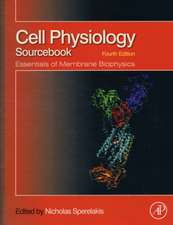Reviews and Protocols in DT40 Research: Subcellular Biochemistry: Subcellular Biochemistry, cartea 40
Editat de Jean-Marie Buerstedde, Shunichi Takedaen Limba Engleză Hardback – 25 oct 2006
| Toate formatele și edițiile | Preț | Express |
|---|---|---|
| Paperback (1) | 1225.94 lei 6-8 săpt. | |
| SPRINGER NETHERLANDS – 3 dec 2014 | 1225.94 lei 6-8 săpt. | |
| Hardback (1) | 1230.66 lei 6-8 săpt. | |
| SPRINGER NETHERLANDS – 25 oct 2006 | 1230.66 lei 6-8 săpt. |
Din seria Subcellular Biochemistry
- 18%
 Preț: 948.79 lei
Preț: 948.79 lei - 5%
 Preț: 1456.88 lei
Preț: 1456.88 lei - 18%
 Preț: 1373.84 lei
Preț: 1373.84 lei - 18%
 Preț: 1243.78 lei
Preț: 1243.78 lei - 18%
 Preț: 2098.81 lei
Preț: 2098.81 lei - 18%
 Preț: 1122.10 lei
Preț: 1122.10 lei - 5%
 Preț: 1160.63 lei
Preț: 1160.63 lei - 18%
 Preț: 1396.26 lei
Preț: 1396.26 lei - 18%
 Preț: 1114.96 lei
Preț: 1114.96 lei - 18%
 Preț: 1224.68 lei
Preț: 1224.68 lei - 18%
 Preț: 951.29 lei
Preț: 951.29 lei - 18%
 Preț: 1227.99 lei
Preț: 1227.99 lei -
 Preț: 398.15 lei
Preț: 398.15 lei -
 Preț: 399.88 lei
Preț: 399.88 lei - 18%
 Preț: 1231.47 lei
Preț: 1231.47 lei - 18%
 Preț: 1230.35 lei
Preț: 1230.35 lei -
 Preț: 392.60 lei
Preț: 392.60 lei - 18%
 Preț: 1231.47 lei
Preț: 1231.47 lei - 15%
 Preț: 638.76 lei
Preț: 638.76 lei - 5%
 Preț: 656.26 lei
Preț: 656.26 lei -
 Preț: 389.49 lei
Preț: 389.49 lei - 5%
 Preț: 659.19 lei
Preț: 659.19 lei -
 Preț: 392.37 lei
Preț: 392.37 lei - 5%
 Preț: 662.09 lei
Preț: 662.09 lei -
 Preț: 395.09 lei
Preț: 395.09 lei - 5%
 Preț: 667.99 lei
Preț: 667.99 lei -
 Preț: 400.47 lei
Preț: 400.47 lei - 18%
 Preț: 1224.54 lei
Preț: 1224.54 lei - 15%
 Preț: 647.73 lei
Preț: 647.73 lei - 15%
 Preț: 646.75 lei
Preț: 646.75 lei - 5%
 Preț: 662.30 lei
Preț: 662.30 lei -
 Preț: 395.25 lei
Preț: 395.25 lei - 18%
 Preț: 1230.21 lei
Preț: 1230.21 lei - 18%
 Preț: 1231.95 lei
Preț: 1231.95 lei - 18%
 Preț: 964.54 lei
Preț: 964.54 lei
Preț: 1230.66 lei
Preț vechi: 1500.81 lei
-18% Nou
Puncte Express: 1846
Preț estimativ în valută:
235.54€ • 244.95$ • 197.10£
235.54€ • 244.95$ • 197.10£
Carte tipărită la comandă
Livrare economică 14-28 martie
Preluare comenzi: 021 569.72.76
Specificații
ISBN-13: 9781402048951
ISBN-10: 1402048955
Pagini: 492
Ilustrații: XII, 477 p.
Dimensiuni: 210 x 297 x 36 mm
Greutate: 0.82 kg
Ediția:2006
Editura: SPRINGER NETHERLANDS
Colecția Springer
Seria Subcellular Biochemistry
Locul publicării:Dordrecht, Netherlands
ISBN-10: 1402048955
Pagini: 492
Ilustrații: XII, 477 p.
Dimensiuni: 210 x 297 x 36 mm
Greutate: 0.82 kg
Ediția:2006
Editura: SPRINGER NETHERLANDS
Colecția Springer
Seria Subcellular Biochemistry
Locul publicării:Dordrecht, Netherlands
Public țintă
ResearchCuprins
DT40 gene disruptions: a how-to for the design and the construction of targeting vectors.- Immunoglobulin gene conversion or hypermutation: that's the question.- Genome resources for the DT40 community.- Chromosome engineering in DT40 cells and mammalian centromere function.- Function of RECQ family helicase in genome stability.- Genetic analysis of apoptotic execution.- The DT40 system as a tool for analyzing kinetochore assembly.- Analysing the DNA damage and replication checkpoints in DT40 cells.- Using DT40 to study clathrin function.- Genetic analysis of B cell signaling.- DT40 mutants: a model to study transcriptional regulation of B cell development and function.- Transcription and RNA processing factors play complex roles in DT40 cells.- Participation of histones, histone modifying enzymes and histone chaperonesin vertebrate cell functions.- Analysis of gene expression, copy number and palindrome formation with a DT40 enriched CDNA microarray.- Calcium signaling, ion channels and more.- Analysis of DNA replication damage bypass and its role in immunoglobulin repertoire development.- The fanconi anemia pathway promotes homologous recombination repair in DT40 cell line.- Phenotypic analysis of cellular responses to DNA damage.- ATM, a paradigm for a stress-responsive signal transducer in higher vertebrate cells.- Stable non-targeted transfection of DT40.- Basic cell culture conditions.- Excision of floxed-DNA sequences by transient induction of MER-CRE-MER.- Immunoglobulin gene conversion and hypermutation assay by facs.- Target screening by PCR.- Mitotic index determination by flow cytometry.- Centrifugal elutriation as a means of cell cycle phase separation and synchronisation.- Preparation of genomic DNA for microarray-based comparative genome hybridization.- Analysis of cellular Mg2+ in DT40 cells.- Transient transfection of DT40.- Retroviral transduction of DT40.- Colony survival assay.- Subcloning DT40 by limiting dilution.- Subnuclear immunofluorescence.- Sister chromatid exchange assay.- 2D cell cycle analysis.- Purification of tap-tagged proteins by two-step pull down from DT40 cells.- Synchronization of cells.- Targeted transfection of DT40 cells.- Luciferase reporter assay.- Indirect immunofluorescence microscopy.- Quantification of receptor-mediated endocytosis.- Measurement of DNA synthesis and strand breaks using alkaline sucrose density gradient centrifugation.- Isolation of nuclear and cytoplasmic proteins from DT40 cell lines.
Caracteristici
State-of-the-art reviews Protocols to help you succeed Frontiers in DT40 science








